The Best Team Productivity Tools in 2024
As deadlines loom and responsibilities pile up, finding the correct tools to streamline workflows, enhance collaboration, and increase productivity becomes crucial for success.

Are you tracking time manually?
Exchange your manual timesheets with automated time tracking to save time on manual work and ensure 100% accurate time entries
Today, you’ll discover powerful and practical tools to boost productivity, foster seamless communication, and facilitate project management.
Emphasizing practicality and tangible results, we cut through the clutter to provide clear and concise insights on each tool’s benefits. Keep reading if you want to know the top team productivity tools that will uplift your team performance.
Top benefits of team productivity tools
- Improved team collaboration: Team productivity tools automatically enhance collaboration, streamlining project completion with minimal effort. This leads to higher quality outcomes and increased revenue with less manual coordination.
- Effortless task management: These tools simplify task management, ensuring projects are completed on time with little manual oversight. This efficiency translates into greater customer satisfaction and retention, positively impacting revenue.
- Automated insights: The tools provide automated analytics and reporting, offering valuable insights with minimal effort. Utilizing these can optimize operations and resource allocation, leading to cost efficiency and an uptick in profitability.
- Workflow automation: Routine tasks are automated (i.e. time tracking process is automated with Timeular), allowing teams to focus on high-value activities with minimal intervention. This increases overall productivity and directly contributes to revenue growth, as the tool handles the repetitive processes.
The 17 best team productivity tools
1. Timeular
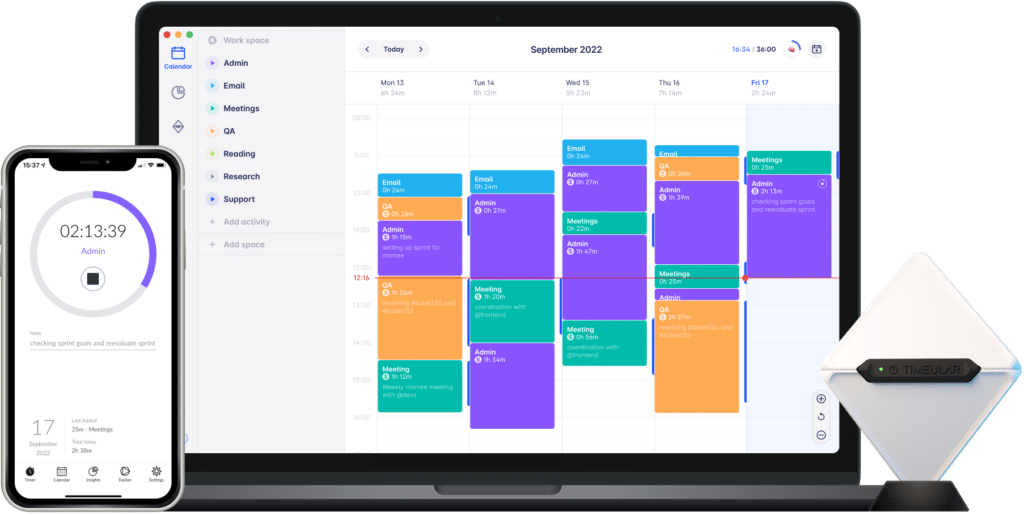
Timeular is one of the best team productivity tools since it’s a productivity tracker designed to help teams track and optimize their time effectively. As a team time tracker, it provides businesses a one-stop-shop to manage worktime, overtime, and leaves.
Its intuitive interface allows teams to effortlessly monitor their activities and gain valuable insights into their daily work routines. Timeular consolidates intelligent timekeeping methods into one platform, allowing time to be tracked in a few seconds per day.
Time tracking boosts the team’s productivity by providing insights into how time is allocated, identifying inefficiencies, and promoting better time management.
Timeular works both as a Windows time tracker and a Mac time tracker.
Top Timeular features for team productivity
- Effortless and intuitive time tracking prevents time wasting. Timeular has a modern and straightforward interface; teams learn to set up Timeular and start tracking time in just 5 minutes.
- Multiple timekeeping methods to track every activity – Timeular brings multiple super simple time tracking methods together in one tool (Tracker, Quicktrack, Automatic tracking, mobile app, 1-click start/stop, calendar integrations, drag and drop, copy/paste).
- Custom reminders to keep your team productive – Timeular sends custom notifications to team members, like a ”take a break” reminder, or start and stop the tracker.
- Automated reporting about team performance – Having a clear overview of how each team member spends their time will help you allocate the right resources to avoid excessive workloads and productivity dips. It’s a great way to measure team effectiveness.
- Automatic tracking to grasp every task and fill timesheet correctly – Every team member can see which apps, docs, and websites they’ve used at which time and what was in their calendar, and then add them to their time tracking overview in one click – no more manual timesheets! Your team’s privacy is protected 100%: The data is stored solely on their local machine, so nobody else can access it, nor the Manager.
- Physical Tracker to build time tracking habit – The Timeular physical Tracker is an 8-sided die that records time for different tasks. Customize each side, then flip it to track a specific activity automatically. It seamlessly connects to your app through Bluetooth.
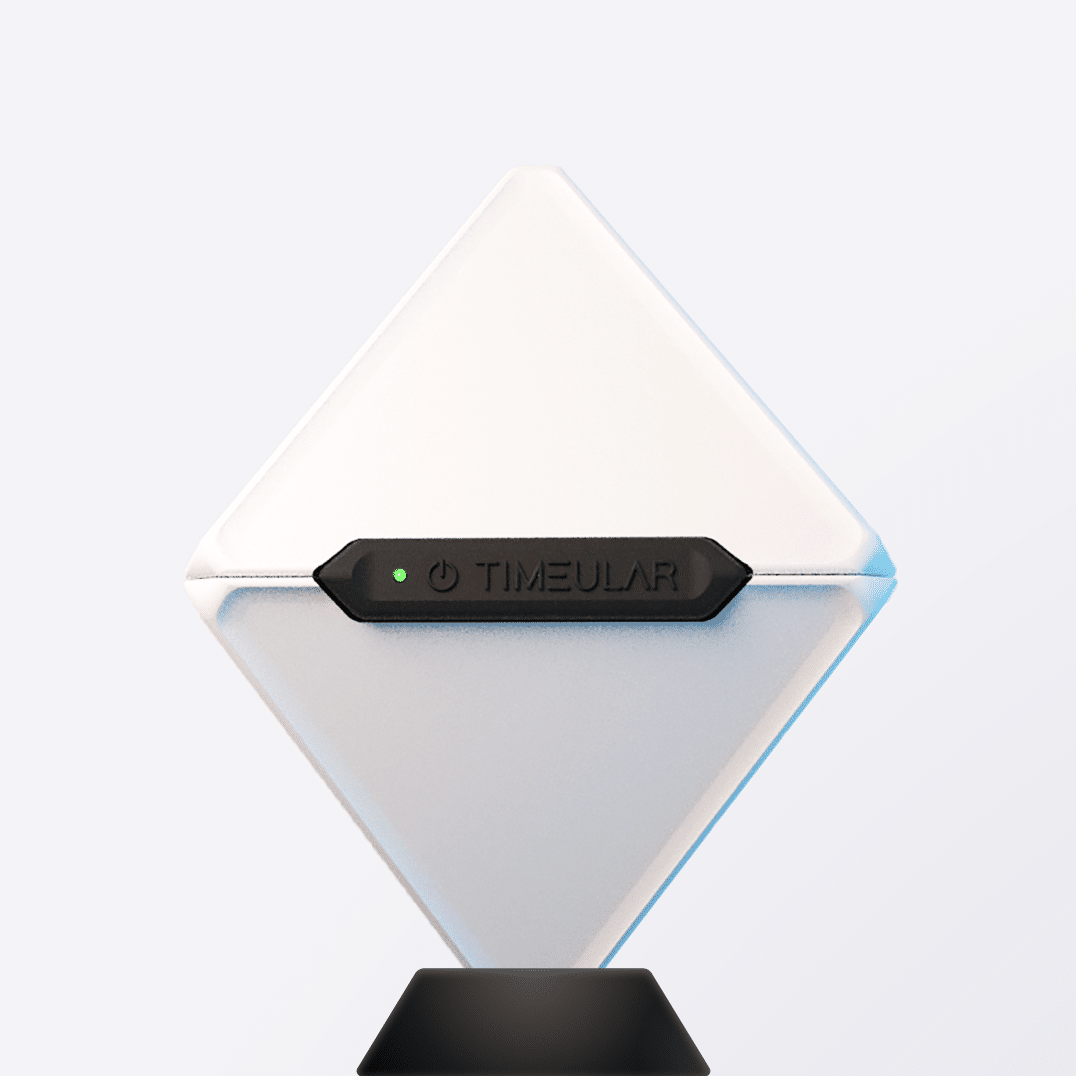
Discover the Timeular Tracker!
Simply flip the tracker to start timekeeping. Make time tracking fun and tactile!
Accurate and actionable insights
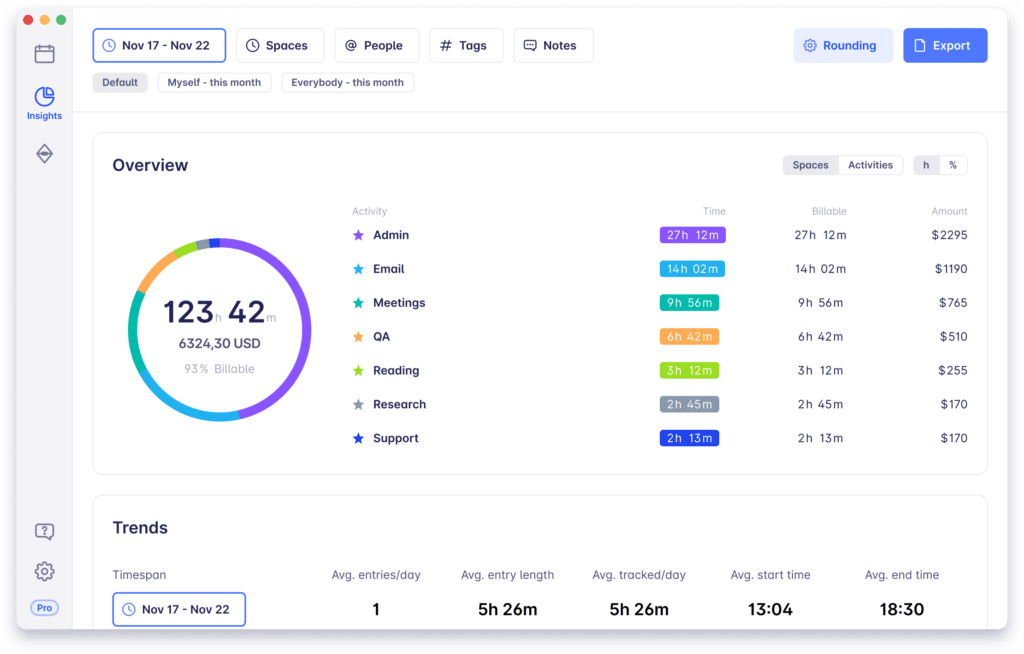
By using Timeular timekeeping software, teams can access their time logs, view detailed reports, and analyze their productivity patterns. The visual representation of data helps users understand where their time is being spent, enabling them to identify areas for improvement and make informed decisions about time allocation. The app provides a precise breakdown of your activities to ensure that each little task is tracked and added to your invoice. You can export your reports to PDF, XLSX, or CSV.
We are much better at accurately tracking our time, which improves client billing
Michele C., Founder at Clementine Healthcare Marketing
Track billable and non-billable hours
Timeular is the greatest billable hour tracker because of its flexibility in tracking such hours. Individual team members can track the same activity as billable or not by simply switching a toggle.
The team gets custom reminders to be productive
The app provides notifications to keep users on track and ensure they maximize their valuable time.

3,000 integrations available
Timeular integrates with all popular project management tools. Teams can seamlessly build connections with their favorite tools via Zapier.
Popular integrations:
- Google Calendar time tracking integration
- Jira time tracking
- GitHub time tracking integration
- GitLab time tracking
Track time with the physical Tracker
The physical tracking device by Timeular is an 8-sided cube that works offline and connects via Bluetooth with the Timeular app. Teams can track up to 1000 activities with just 8 sides by leaving one or more sides of the Tracker empty that, when flipped, will open Quicktrack and let them choose what they want to track.
Track any leave and keep over-hours in check
Teams can use Timeular as a leave and PTO tracker to add and track any type of leave. This enables team leaders to monitor all leave requests from the whole team, avoiding frustration and mistakes by manually tracking leave requests in spreadsheets. In Timeular, it is also possible to track work hours for full- and part-time workers, including over- and minus hours.

Help your team achieve sky-high productivity with a smart time tracking solution
Track time together with your team to optimize your workflows and boost efficiency levels
2. Asana
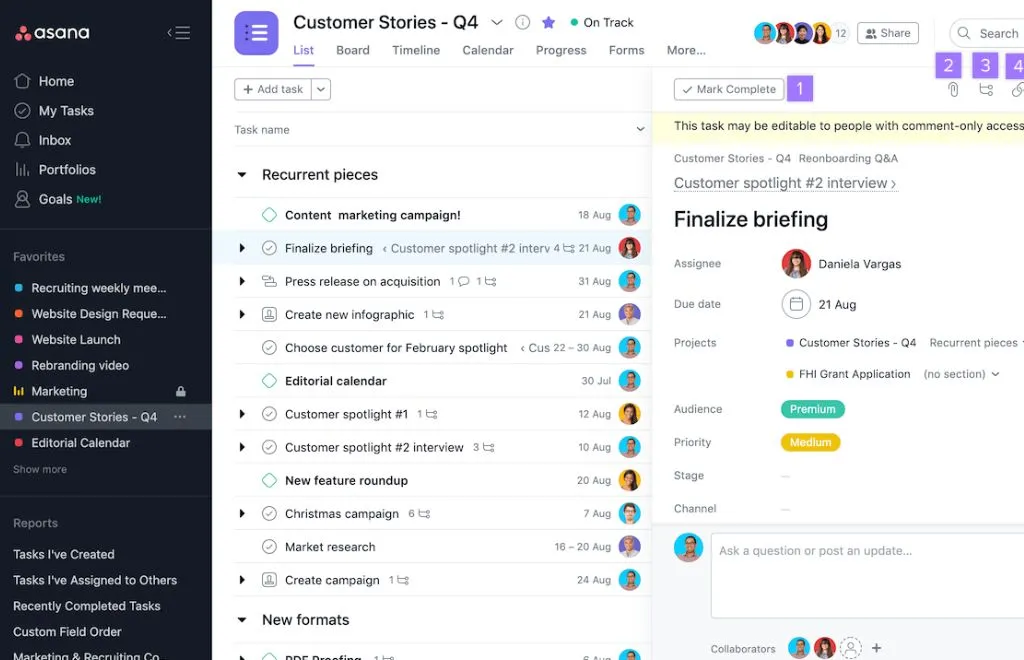
Asana is a popular project management and collaboration app that helps individuals and teams organize and manage work. It’s popular for a good reason, as reviews online mention great UX and this tool’s flexibility as helping streamline workflows.
Asana allows you to create tasks, assign them to team members, set due dates, and track progress. You can add descriptions, attachments, and subtasks to provide detailed information and context for each one, providing a timeline and calendar views.
Read also: Best working from home apps
It also notifies you of any task updates, comments, and changes made by team members, ensuring you stay connected and aware of project progress.
Asana integrates with other apps such as Slack and Google Drive, streamlining workflows and ensuring information flows seamlessly between platforms.
Considered an excellent AI tool for productivity, Asana caters to teams of all sizes and industries. It is equally beneficial for small startups, large enterprises, marketing teams, development teams, or any other team that requires efficient task management.
Two disadvantages pointed out by those who use Asana are:
- Asana time tracking: the in-built time tracking features are not easy to use and accurate
- Pricing structure: can be considered too high for some user
Read also: Best AI tools for business
3. Slack
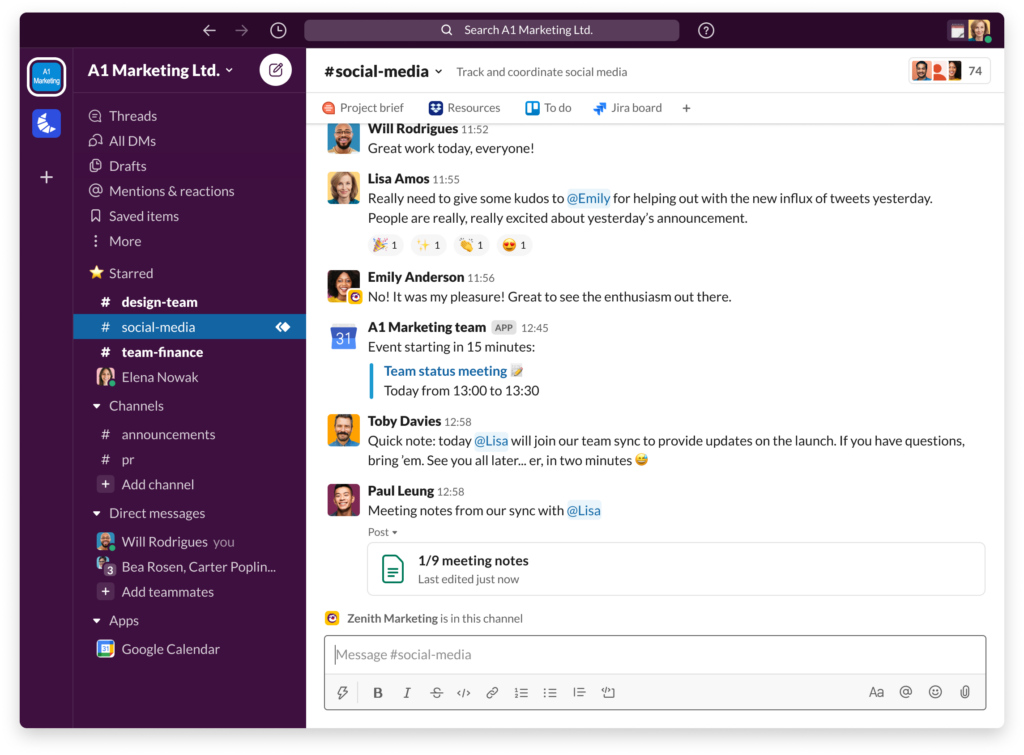
Widely used as a team management software, Slack is a leading team collaboration platform that offers versatile communication among teams, helping streamline workflows. Slack caters to all industries and teams of all sizes.
It provides a centralized and real-time messaging system, enabling seamless interaction, file sharing, and integration with numerous tools to enhance productivity.
Slack, one of the best apps for team communication, is a favorite for many organizations with its intuitive interface and powerful integrations.
Slack provides a channel-based structure for teams to gather and collaborate on specific projects or topics.
It allows instant messaging, voice and video calls, and file sharing, which improves team communication making it easy for teams to stay connected and work together efficiently.
The app offers a wide range of integrations with popular productivity tools and services, from Google Calendar to Google Drive, to Hubspot, Jira, and Zoom, among others.
Slack’s robust search functionality ensures that important information and past conversations are easily retrievable. For this, it’s regarded by reviewers for its effectiveness in team communication.
Users like the fact that all conversations can be found in one place and highlight integrations and existent plugins.
Slack can be used for free, with limited integrations and message history. For some users, this is a negative point since the message’s history disappears after some time.
Read: Slack time tracking integration
4. Todoist
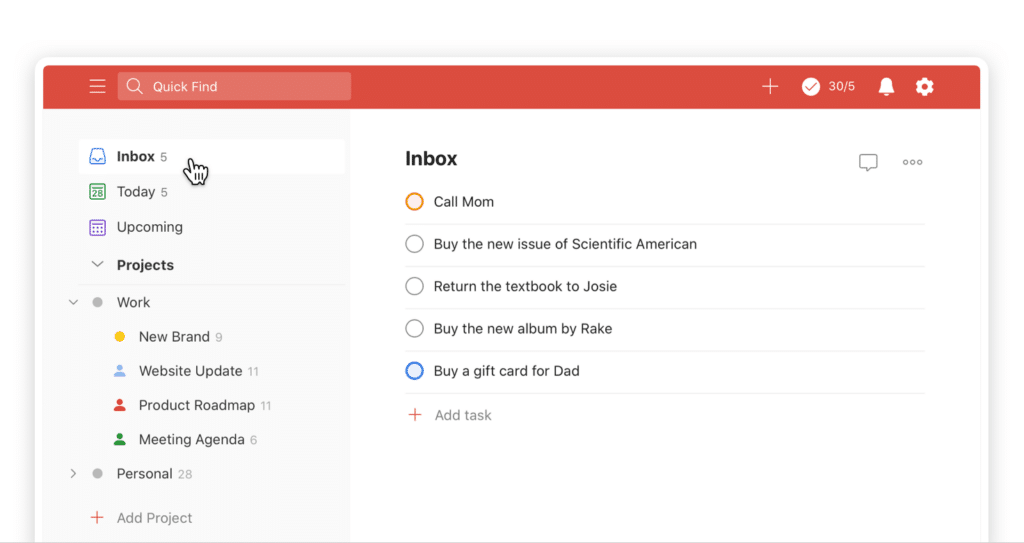
Todoist is a task management software that helps individuals and teams stay organized, track tasks, and manage projects efficiently. It offers a simple yet powerful platform to manage to-do lists and collaborate on tasks in real-time.
With Todoist, one of the best productivity apps, teams improve their productivity by effectively managing their workload by creating tasks, setting due dates, prioritizing activities, and organizing them into projects and sub-tasks. It’s also possible to organize tasks by priority or frequency.
Todoist’s synchronization abilities mean that users can access their tasks from any device, making it easy to stay on top of their responsibilities.
Todoist can be used by individuals, small teams, and larger organizations. Its customization options allow for this tool to suit professionals across different industries.
The intuitive design of this tool ensures that users can quickly adopt the platform without a steep learning curve, share tasks, collaborate with colleagues, and delegate responsibilities.
Even though Todoist integrates with various apps and platforms, its free plan integrations and features are limited.
Online reviewers appreciate Todoist’s ability to manage tasks effectively and prioritize them based on urgency, as well as the possibility of synchronizing them across devices.
A free Todoist plan allows for maintaining 5 active projects.
Read also: Boot your team performance by tracking time in Todoist.
5. Notion
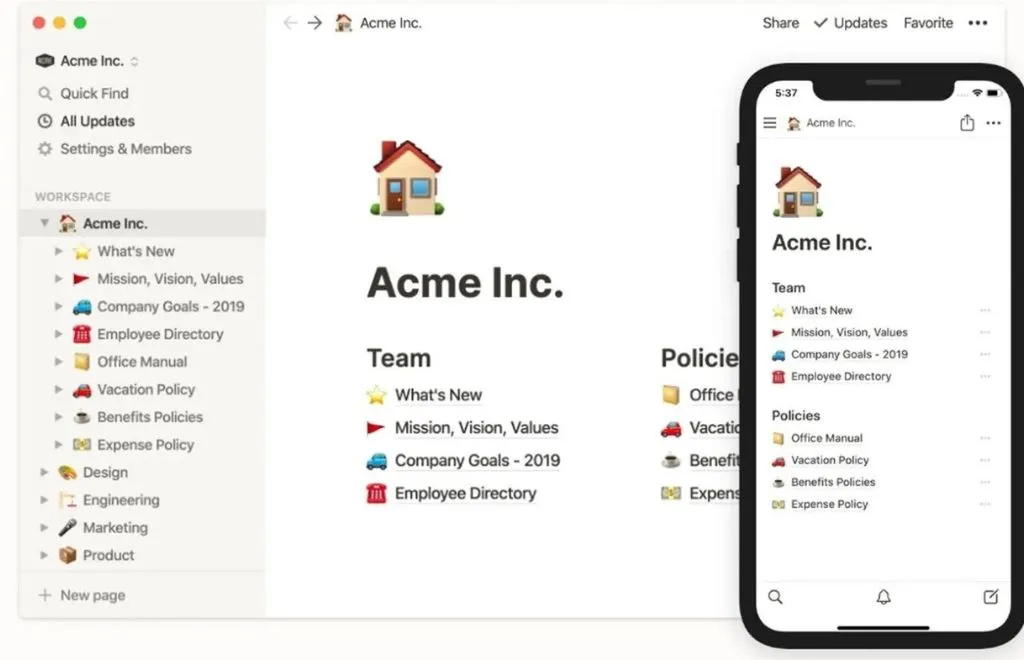
Notion is a versatile all-in-one team productivity tool that allows users to organize their work, collaborate with teams, and manage projects.
Notion consists of a flexible workspace where users can create pages, databases, and boards to organize their information in a way that suits their workflow.
Notion is designed to cater to a broad audience, making it suitable for individuals, small teams, and large organizations across various industries.
It is commonly used by content creators, project managers, developers, marketers, and even students.
Notion includes features to manage tasks and projects, such as the creation of to-do lists, notes, tasks, and calendars, and it facilitates collaboration and the sharing of information. That’s why it’s one of the most used project management apps.
Team members can work on documents and projects simultaneously. Notion integrates with many other tools, such as Trello, Google Drive, and Slack.
Still, it’s important to make a note of the limited offline access that Notion offers, that is limited, and of its pricing structure, which may be considered relatively high for users requiring advanced features.
In platforms such as Capterra, Notion has received positive reviews for its versatility and adaptability. Users appreciate its capability to create personalized workflows and templates.
There is a free plan, perfect for an individual worker or freelancer.
TIP: Discover the best Notion time tracker
6. Trello
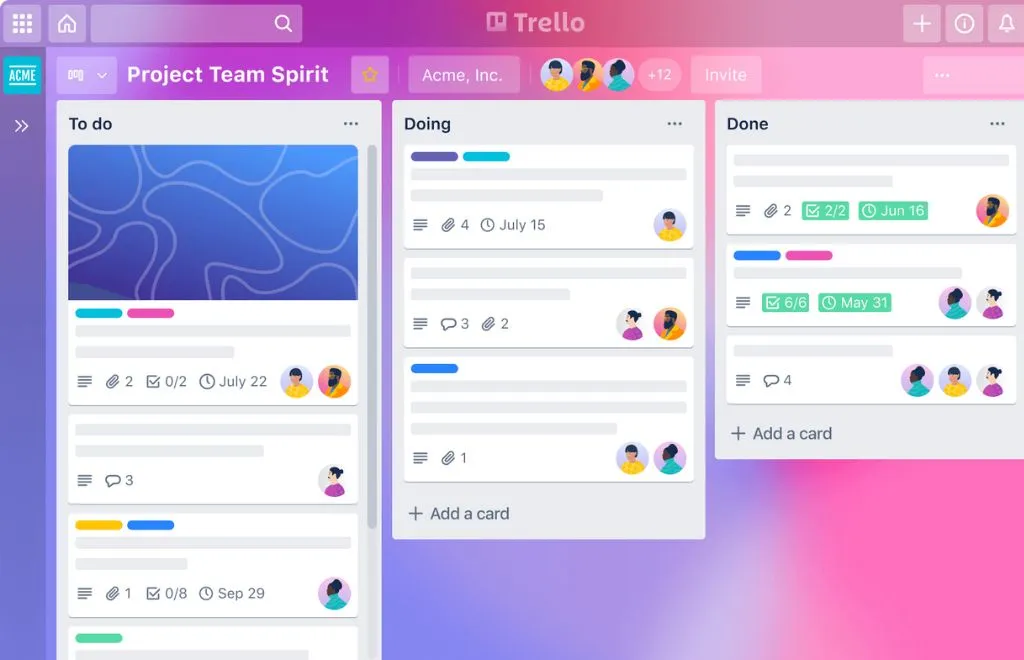
An excellent tool for managing remote employees, Trello uses Kanban boards, lists, and cards to help individuals and teams organize and track tasks and projects.
The structure is flexible, and users can create multiple boards for different projects, add lists within each board to represent workflow stages, and create cards to represent individual tasks or items.
It utilizes a flexible Kanban-style approach to task management, making it easy to manage workflows and stay on top of assignments. For this reason, it’s a pretty popular tool among developers, content creators, and social media managers.
Within each board, users can create lists representing different stages or phases of a project and drag and drop cards between lists to indicate progress.
Users highlight this feature and its user-friendly interface, making it easier to get started quickly without much training. This team productivity app integrates with various third-party applications and services, allowing users to connect with other tools they already use.
Some users also reported that Trello can be a great software for time blocking.
However, some reviewers note that Trello might not be the best choice for large and complex projects, as it lacks certain advanced functionalities.
Read also: Increase team productivity by adopting a Trello time tracking integration.
7. Clickup
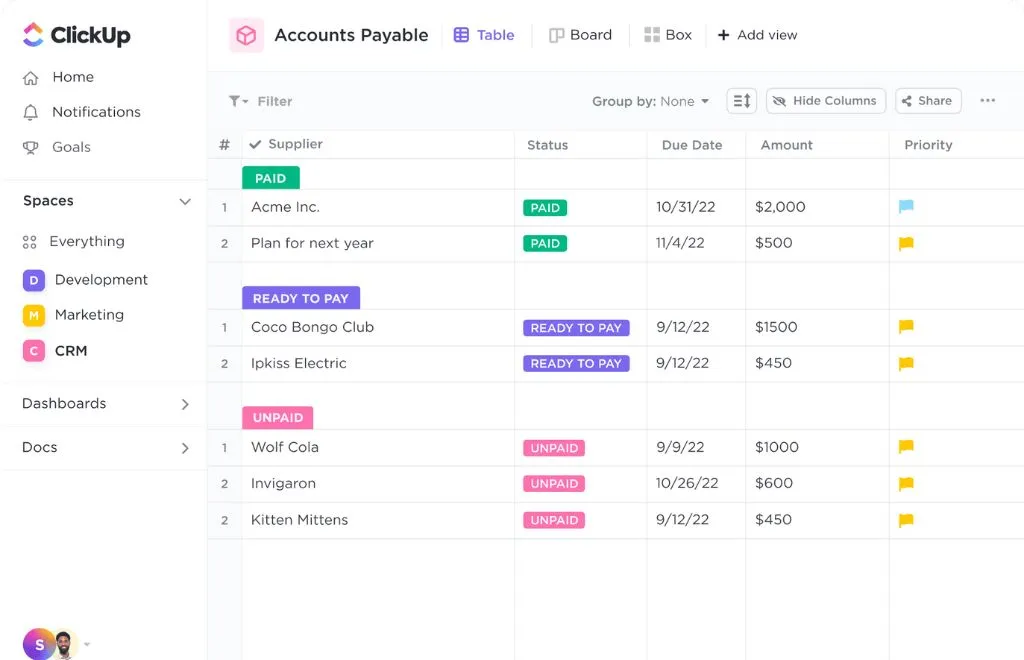
ClickUp is a project management and productivity platform designed to centralize all aspects of project management within one application, making it a versatile solution for various industries and team sizes.
This platform supports customizable task views and task dependencies, enabling developers to organize and prioritize their work.
It’s one of the best developer productivity tools, and it’s also a favorite of sales and creative teams. Clickup supports Agile methodologies, such as Scrum and Kanban, with features like Sprint Boards, Burndown Charts, and Agile Dashboards.
To facilitate things further, this tool integrates with numerous popular third-party tools, around one thousand of them, such as GitHub, GitLab, Jira, or Slack.
With various features integrated into one platform, ClickUp reduces the need for using multiple tools, leading to improved efficiency and seamless collaboration.
The app supports automation features, enabling developers to create custom processes to save time on those repetitive tasks that always steal so much time. However, it’s important to note that while Clickup offers a vast group of features, it may be more suitable for complex projects and larger development teams. Clickup might be potentially overwhelming for smaller-scale projects, with some reviewers online reporting some performance issues.
TIP: Read our blog and find out what is the best ClickUp time-tracking integration
8. Monday.com
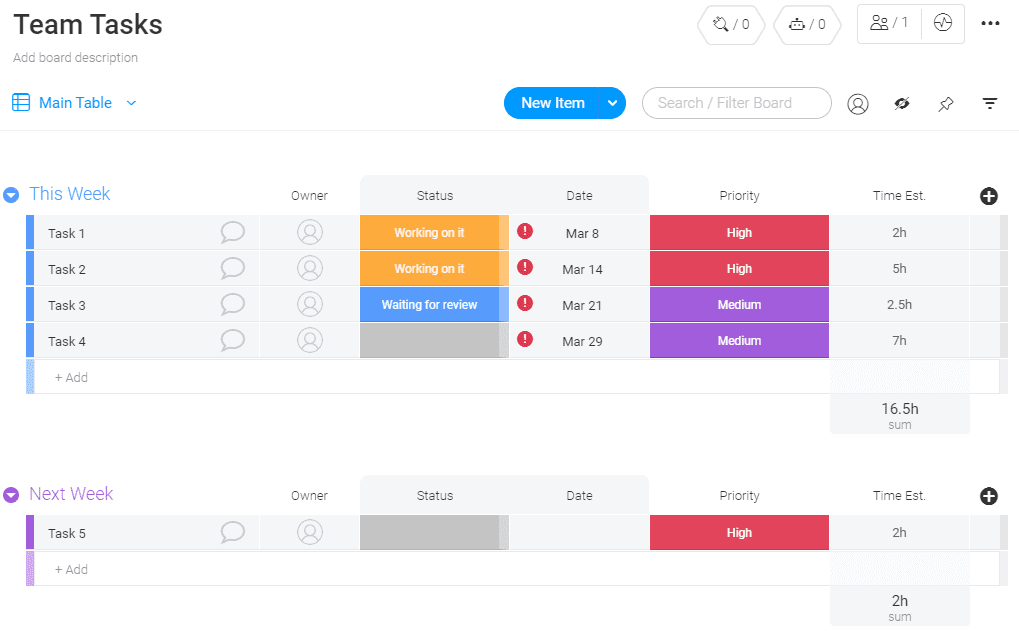
Monday.com is a cloud-based work software that streamlines collaboration and project management for teams of all sizes. It’s a tool that suits different industries, including marketing, software development, construction, creative agencies, event management, and more, serving organizations of all sizes, from small startups to large enterprises.
Users can tailor their boards and workflows to match specific project management needs and use real-time collaboration features, such as task assignments, comments, and notifications.
One downside: while Monday.com provides various pricing plans, some businesses may find it relatively more expensive than other project management tools, especially for larger teams with complex needs.
Read also: The best Monday.com time-tracking integration
9. Wrike
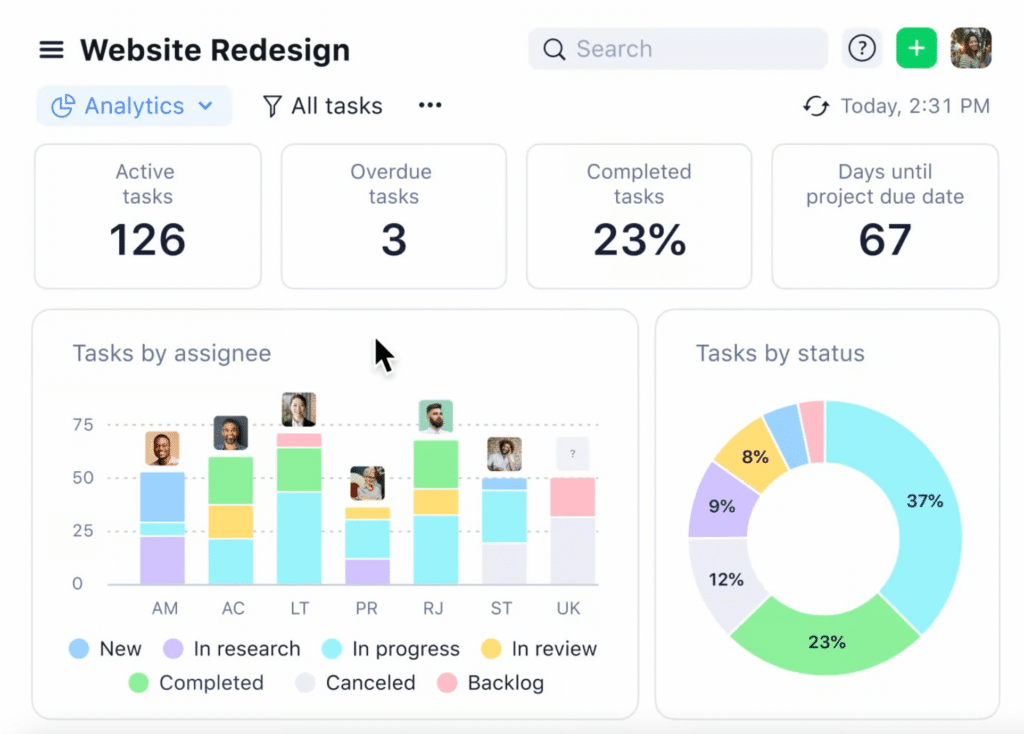
Wrike is a top resource planning software that provides project management features to a wide range of industries and teams of different sizes seeking efficient and effective project planning.
Wrike offers users a centralized workspace for teams to create, assign, and track tasks and projects. It offers a variety of views that suit different roles within a company, including Gantt charts, Kanban boards, and traditional task lists, allowing teams to work in the visual format that best suits their needs.
Wrike aims to enhance team communication, optimize task management, and provide transparency throughout the project lifecycle.
Reviewers consider Wrike one of the best team productivity software for remote teams in any industry due to its real-time document collaboration features.
It has a very data-driven approach, facilitated by reporting and analytical capabilities, and integrates with various third-party tools and platforms, including, for example, Slack and Microsoft Teams.
Wrike’s flexibility and automation capabilities appeal to users who choose this tool, but some also say that the software can be too complex for more straightforward projects.
Read also: Wrike time tracking integration
10. Grammarly
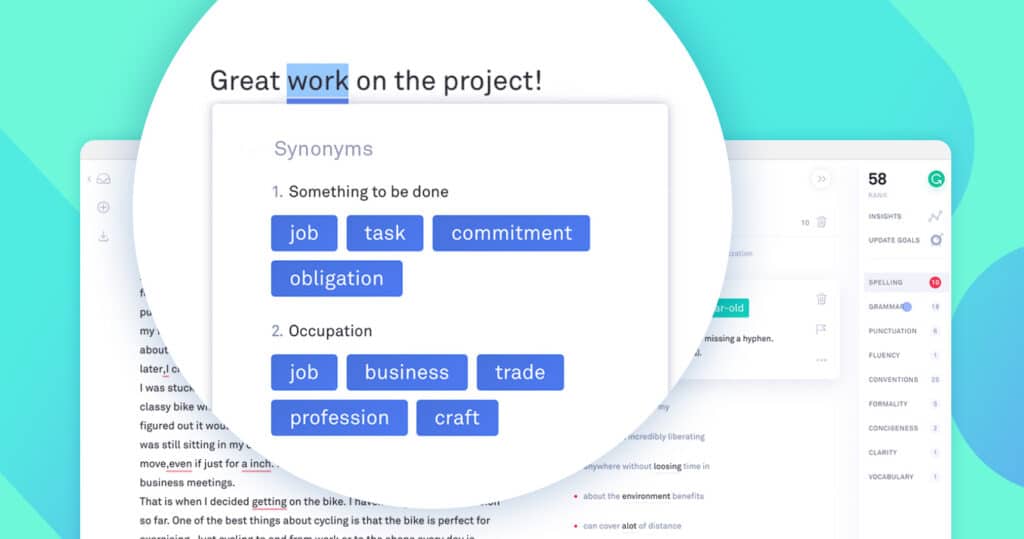
Grammarly is a must-have team productivity tool for almost any team and business. It’s an artificial intelligence writing assistant that helps to improve grammar, spelling, and writing style.
A good AI marketing tool, it can be used across various platforms, including web browsers, desktop applications, and mobile devices, making it accessible for individuals and teams from different industries.
Grammarly uses advanced algorithms to analyze written content and provide real-time feedback to users. It offers suggestions for grammatical errors, spelling mistakes, punctuation, and more.
In its premium plan, it also provides insights into writing clarity, engagement, and tone, important features for someone who’s not an English native but is required to communicate in this language.
Additionally, Grammarly can be integrated into various platforms, including web browsers, Microsoft Office, Google Docs, and more.
Users generally praise Grammarly for its effectiveness in improving writing quality. The interface and real-time suggestions are often highlighted as the most significant advantages.
Users appreciate the personalized feedback and the ability to use Grammarly across different platforms.
However, on the downside, some reviewers mention the premium pricing as a drawback, especially considering that some grammar and spelling checkers are available for free.
Read also: Discover the best tips to successfully manage and lead a remote team.
11. Microsoft 365
Microsoft 365, formerly known as Office 365, is one of the best Windows productivity tools and collaboration apps offered by Microsoft.
This powerful productivity suite offers a comprehensive set of applications and services. Microsoft 365 includes Microsoft Word, Excel, PowerPoint, Outlook, OneNote, Teams, and other apps used to create documents, analyze data, design presentations, manage emails, and capture notes, catering to a wide range of personal and professional needs.
Familiar Microsoft Office applications are combined with cloud services, and collaboration features, providing users with a comprehensive solution for various tasks in both professional and personal settings.
Microsoft 365 caters to individuals, small businesses, and large enterprises alike. It is suitable for all kinds of teams and industries, for students to professionals.
One of the main advantages of using this tool is the familiarity that so many users already have with the applications, making the transition to Microsoft 365 seamless.
With the suite for Windows, whether working from a desktop, laptop, or tablet, users can access their documents, spreadsheets, presentations, and emails everywhere, ensuring seamless productivity and collaboration across team members and multiple devices.
This fosters effective teamwork, eliminates version control issues, and ensures that everyone is working on the most up-to-date content.
Read also
12. Google Workspace
A Google Workspace is a collaboration suite offered by Google. A favorite of many professionals across virtually every industry, for companies of every size, and for sure, one of the best small business tools.
It combines a range of applications and communication tools to facilitate seamless teamwork, file sharing, and productivity within organizations.
Inside Google Workspace, several valuable and well-known tools can be found: Google Sheets, Docs and Slides, Google Forms, Gmail, Google Meet, Google Drive, Google Calendar, and others.
Since it’s one of the most used systems in the business world, device compatibility is guaranteed. The main highlights of Google Workspace include its cloud-based nature, which enables easy access, collaboration, and synchronization across devices.
The suite ensures robust security measures, data encryption, and administrative control to ensure data protection and privacy.
While Google Workspace offers various pricing plans, some organizations may find the cost relatively high, especially for larger teams or those with specific requirements.
Read also:
Google Sheets time tracking template
The best apps for Android
13. Google Drive
Google Drive is a versatile cloud storage and file synchronization service that offers an array of features designed to enhance productivity.
Even though it is part of Google Workspace, it deserves its spot on the list. It also can be used separately from the other apps for storing, sharing, and accessing files across devices.
From the start, Google Drive offers 15 GB of storage for free use. Being a part of the Google Workspace suite, along with Google Docs, Sheets, and Slides, users can create and edit files together, seeing changes made by collaborators in real time.
Its popularity and versatility show that Google Drive is suitable for users and teams of all sizes and industries. It is widely used by students and professionals alike, who highlight the reliability of this tool.
Files stored on Google Drive can be accessed from any device with internet access, promoting remote work and flexibility. It keeps track of version history, enabling users to access and revert to previous file versions if needed.
While it provides free storage, users may need to purchase additional storage for large amounts of data, and this may be seen as a disadvantage by some, as well as the fact that offline access to files is limited.
Read also: Remote work guide
14. JIRA
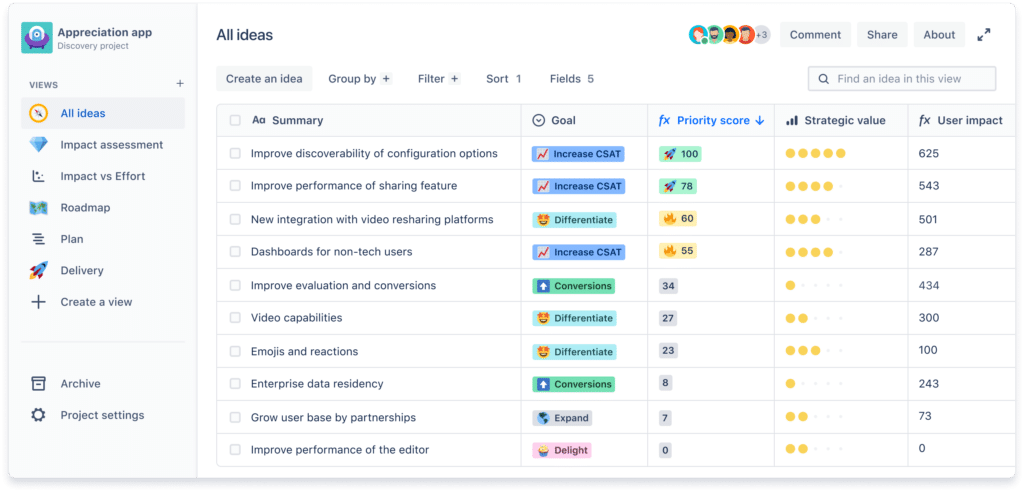
JIRA is an issue-tracking and project-management tool developed by Atlassian. It is widely used in software development to efficiently track and manage projects, tasks, and issues. Still, its flexibility and scalability make it suitable for teams in various industries seeking efficient project management.
This tool provides a platform for teams to create and manage tasks, bugs, features, and other project-related items. It’s known for providing customizable and real-time collaboration, making it a valuable tool for agile development and project management.
JIRA provides tools to set priorities and allocate resources effectively, ensuring teams work on the most critical tasks first while integrating with other collaboration tools.
It’s important to note that its software development orientation can be difficult for non-technical users, who may need additional training when using this tool.
Online reviewers generally praise JIRA for its customization options, integration with other tools, and agility in managing complex development workflows.
Pricing plans will always depend on the number of agents that’ll use the tool.
Read also: The most effective techniques to lead a project to success
15. SmartSheet
Smartsheet is a project management software that allows you to set deadlines, assign tasks, track progress, and collaborate with team members in real-time.
Smartsheet is suitable for teams of all sizes and industries, including marketing, software development, finance, human resources, and more. Its versatility makes it appealing to any team that requires effective project planning, task management, and collaboration.
Smarsheet enables the visualization of project timelines using Gantt charts or Kanban boards, two popular choices to do it. With Smartsheet, it’s possible to track resource availability, assign resources to tasks, and balance workloads to avoid major discrepancies between team members. (Read our article, if you want to learn how to do a workload analysis to avoid imbalanced workloads)
Smartsheet’s familiar spreadsheet-like interface makes it easy for users to adopt and start using the platform quickly. It’s important to note that adequate training and support may be required to maximize its potential and ensure smooth adoption. Some users feel that it may lack certain advanced functionalities found in other dedicated project management tools and that customization capabilities are limited.
TIP: Discover the best cost management software
16. Zapier
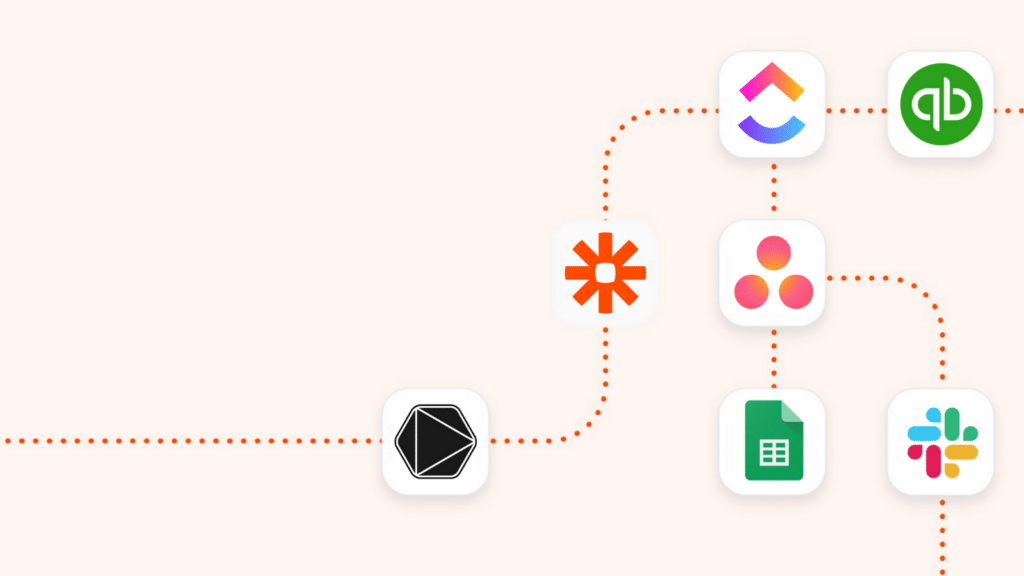
Zapier is one of the best web-based automation tools that connect various apps and services to automate repetitive tasks and workflows.
It allows users to create “zaps,” which are automated actions triggered by specific events. For example, receiving an email or doing a form submission. Zapier allows automatic data transfer and eliminates the need for manual intervention.
It works as a bridge between apps. It integrates with thousands of apps, around 3000, including Gmail, Slack, Trello, and Google Sheets.
It’s a widely popular tool that benefits marketers, developers, sales teams, project managers, and virtually anyone seeking to streamline repetitive tasks and improve productivity through automation.
Its popularity is proved by online reviews, with users highlighting the ability to automate tasks without the need for coding or technical expertise, as well as its user-friendly interface and real-time updates. However, they also mention that certain apps may have limitations in terms of available actions, which could be a limitation for some workflows.
Additionally, some users have mentioned that the pricing may be a concern for larger teams or those requiring more advanced automation scenarios.
- Read also: Team management guide
17. Range
Range is a team communication tool for check-ins and meeting management. It focuses on improving team workflows by offering features such as daily stand-ups, check-ins, and goal tracking.
It helps teams stay connected, aligned, and accountable for their tasks and progress. Range is designed for teams of all sizes and industries, being especially useful for remote-first teams.
In this team productivity software users can manage tasks, have discussions, and conduct meetings and virtual retrospectives.
The platform’s daily stand-ups and check-ins facilitate regular updates and promote transparency among team members. Reviewers online highlight its user-friendly interface and meeting options but also mention its lack of more advanced features.
Range’s free plan includes up to 12 users. The Pro plan costs 8$ per team member with unlimited check-in history.
- Read also: virtual retrospective ideas
Conclusion
Increasing team productivity is crucial for achieving success in today’s fast-paced work environment.
Putting these tools to use is the first step for a more productive workflow. Teams need to explore and select the tools that align best with their unique requirements and preferences.
Ultimately, Timeular emerges as a key productivity tool for accurate timekeeping. It allows teams to optimize their workflows, and spot bottlenecks and time-consuming tasks. Timeular stands out as it simplifies time tracking with an intuitive interface and multiple tracking methods. It offers custom reminders and automated reporting for better time management and insights.
The Physical Tracker, an 8-sided die, enhances tracking. Users access accurate insights, billable hour tracking, and integration with 3,000+ project management tools via Zapier. It’s a powerful tool to optimize team productivity and make informed decisions about time allocation.
FAQ
Team productivity refers to the collective level of efficiency and effectiveness accomplished by a group of individuals, known as a team when it accomplishes its goals and objectives. It measures how well the team can collaborate, coordinate efforts, and use available resources to achieve their desired outcomes.
Productivity tools are software applications or resources designed to help individuals or teams work more efficiently and effectively.
These platforms should streamline workflows, automate repetitive tasks, enhance organization, and optimize time management.
Productivity tools can be used in various aspects of work and personal life in order to achieve certain goals or just better results in our daily tasks.
You might be interested in: